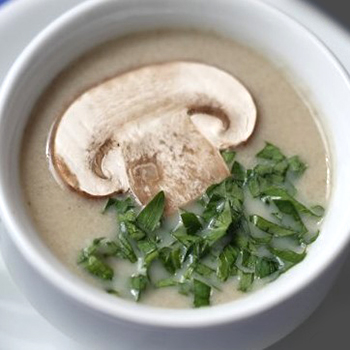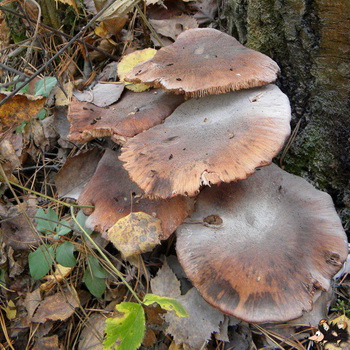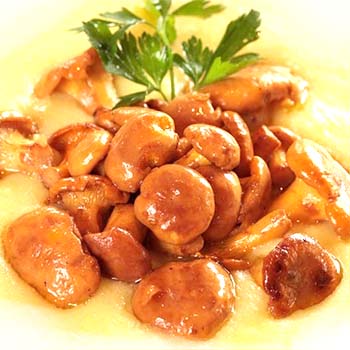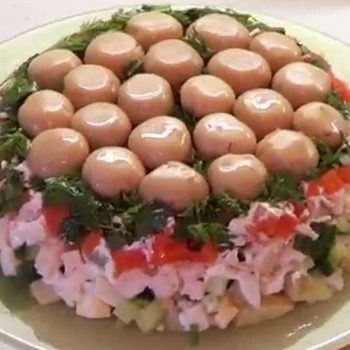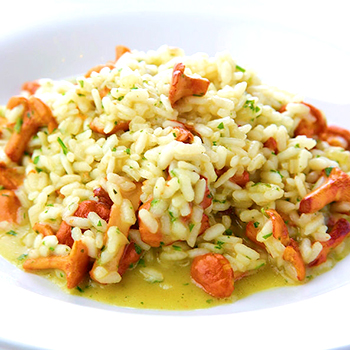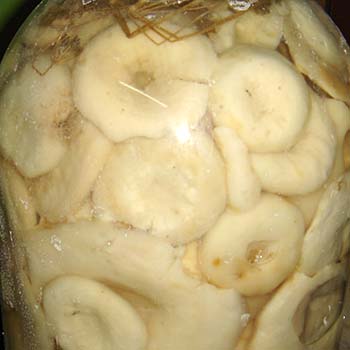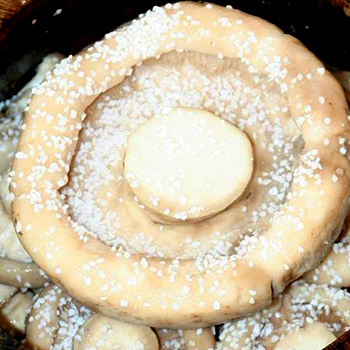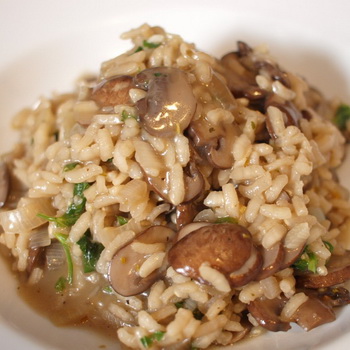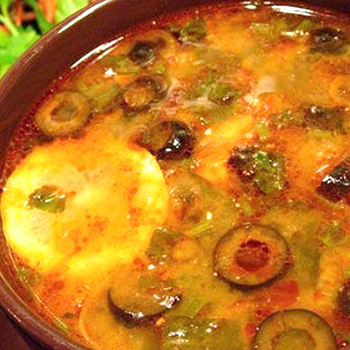Green ryadovka mushroom (green tea): photo, description, differences from sulfur-yellow ryadovka, harvest season
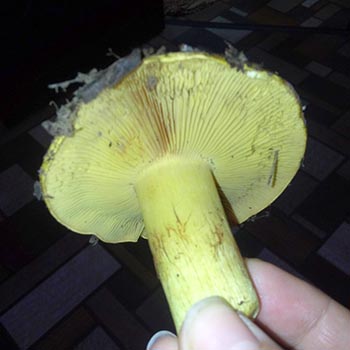 After the end of the peak of the mushroom picking season in the forests, you can still find a green rower (green tea). And although frost and snow are already "looming" ahead, lovers of "quiet hunting" do not refuse to collect fresh "trophies" with such a specific and original color as this one.
After the end of the peak of the mushroom picking season in the forests, you can still find a green rower (green tea). And although frost and snow are already "looming" ahead, lovers of "quiet hunting" do not refuse to collect fresh "trophies" with such a specific and original color as this one.
Green ryadovka mushrooms are widespread throughout Russia. However, often novice mushroom pickers confuse green tea with green russula, and this especially happens when the green ryadovki are at a young age. For comparison, see a photo of a green ryadovka mushroom and a green russula.
However, even if confusion occurs, there is no need to be intimidated. Both of these types are edible, and on the table in the form of a delicious snack will never be in the way.
Ryadovka green (green tea): photo and description


 It is worth saying that various scientific sources providing a description and photo of the green row indicate the conditional edibility of this fruit body. But modern biologists believe that the substances that give the green color to the cap are not destroyed during heat treatment and can lead to poisoning, which poses a danger to the human cardiovascular system. Scientists have found that when a large dose of green rows is consumed, the blood viscosity and the number of platelets increase. And this can lead to the development of a heart attack and thrombosis. However, on the other hand, these fruit bodies contain proteins, fats and carbohydrates, as well as vitamins B1, B2, PP and D, which are necessary for the human body. In addition, ryadovka green (green tea) is rich in carotene, phosphorus and pantothenic acid. So, based on the foregoing, it should be borne in mind that it is prohibited to eat such a mushroom in large quantities.
It is worth saying that various scientific sources providing a description and photo of the green row indicate the conditional edibility of this fruit body. But modern biologists believe that the substances that give the green color to the cap are not destroyed during heat treatment and can lead to poisoning, which poses a danger to the human cardiovascular system. Scientists have found that when a large dose of green rows is consumed, the blood viscosity and the number of platelets increase. And this can lead to the development of a heart attack and thrombosis. However, on the other hand, these fruit bodies contain proteins, fats and carbohydrates, as well as vitamins B1, B2, PP and D, which are necessary for the human body. In addition, ryadovka green (green tea) is rich in carotene, phosphorus and pantothenic acid. So, based on the foregoing, it should be borne in mind that it is prohibited to eat such a mushroom in large quantities.
 Although the green ryadovka mushroom (green tea) can be prepared in different ways: fry, boil, salt, pickle, stew, it should be consumed only in limited quantities. One important rule must be remembered: wash the mushrooms thoroughly and peel the cap. If mushrooms are salted, boiled or pickled, a beautiful rich green mushroom color is obtained in a jar. And if you properly prepare the green ryadovka and use it in reasonable quantities, you get an excellent vitamin supplement to your daily diet, especially in the winter period.
Although the green ryadovka mushroom (green tea) can be prepared in different ways: fry, boil, salt, pickle, stew, it should be consumed only in limited quantities. One important rule must be remembered: wash the mushrooms thoroughly and peel the cap. If mushrooms are salted, boiled or pickled, a beautiful rich green mushroom color is obtained in a jar. And if you properly prepare the green ryadovka and use it in reasonable quantities, you get an excellent vitamin supplement to your daily diet, especially in the winter period.
The green ryadovka mushroom (greenfinch) prefers all forest zones of the country: more often mixed and coniferous, less often deciduous.
 Growing on dry sandy soils, this mushroom rarely becomes wormy. In this article, we will provide a full description and photo of green row mushrooms so that every lover of "quiet hunting" can recognize this fruiting body in the forest and harvest the appropriate crop.
Growing on dry sandy soils, this mushroom rarely becomes wormy. In this article, we will provide a full description and photo of green row mushrooms so that every lover of "quiet hunting" can recognize this fruiting body in the forest and harvest the appropriate crop.
 The name of the green ryadovka comes from the characteristic appearance of the fruit body, which is distinguished by the bright green color of the cap. Even during heat treatment, the color of the mushrooms is completely preserved. The presented photo of the green row will allow each mushroom picker to find out how it looks and to study the representative of the row in detail.
The name of the green ryadovka comes from the characteristic appearance of the fruit body, which is distinguished by the bright green color of the cap. Even during heat treatment, the color of the mushrooms is completely preserved. The presented photo of the green row will allow each mushroom picker to find out how it looks and to study the representative of the row in detail.
Latin name: Tricholoma eguestre.
Family: Ordinary.
Synonyms: green tea, green ryadovka, green mushroom.
 Hat: has a strong and dense body, which is practically not spoiled by worms. A photo of a greenfinch mushroom shows that the cap is fleshy and convex in the early stages. At a later age, it becomes widespread and almost flat, often cracking radially. Diameter from 3 to 15 cm, with a bright green or green-yellow tint. The center of the cap is darker in color, covered with small scales.In wet weather, the cap becomes slippery and sticky, which makes it possible to adhere to sand, leaves and grass.
Hat: has a strong and dense body, which is practically not spoiled by worms. A photo of a greenfinch mushroom shows that the cap is fleshy and convex in the early stages. At a later age, it becomes widespread and almost flat, often cracking radially. Diameter from 3 to 15 cm, with a bright green or green-yellow tint. The center of the cap is darker in color, covered with small scales.In wet weather, the cap becomes slippery and sticky, which makes it possible to adhere to sand, leaves and grass.
 Leg: short, slightly thickened downwards, at the base covered with small brown scales. In the photo of a row of green (greenfinch), it can be seen that the leg is completely hidden in the soil. However, its color is immediately noticeable because it has a green or greenish-yellow color.
Leg: short, slightly thickened downwards, at the base covered with small brown scales. In the photo of a row of green (greenfinch), it can be seen that the leg is completely hidden in the soil. However, its color is immediately noticeable because it has a green or greenish-yellow color.
 Pulp: dense, white, in adulthood acquires a yellowish tint. When broken or cut, the color changes immediately. The taste is not pronounced, but it smells like fresh flour. Green rows growing on pines have a stronger aroma.
Pulp: dense, white, in adulthood acquires a yellowish tint. When broken or cut, the color changes immediately. The taste is not pronounced, but it smells like fresh flour. Green rows growing on pines have a stronger aroma.
Plates: thin, lemon or greenish-yellow in color, which becomes darker with age.
 Application: green tea can be salted, fried, marinated, stewed and boiled. Many consider fried green rows to be the most delicious, and in this case they do not have to be boiled.
Application: green tea can be salted, fried, marinated, stewed and boiled. Many consider fried green rows to be the most delicious, and in this case they do not have to be boiled.
How to distinguish greenfinches from gray-yellow rows and when to pick these mushrooms
 Similarities and differences: greenfinch mushroom is very similar to poisonous sulfur-yellow ryadovka. How to distinguish green tea from a row of sulfur-yellow, so that poisoning does not occur? First of all, you need to pay attention to the smell and color of the mushroom that is in front of you. The main difference between ryadovka sulfur-yellow and greenfinch is the unpleasant smell of tar soap, bitter taste and dirty yellow color.
Similarities and differences: greenfinch mushroom is very similar to poisonous sulfur-yellow ryadovka. How to distinguish green tea from a row of sulfur-yellow, so that poisoning does not occur? First of all, you need to pay attention to the smell and color of the mushroom that is in front of you. The main difference between ryadovka sulfur-yellow and greenfinch is the unpleasant smell of tar soap, bitter taste and dirty yellow color.
 Also, the mushroom has a resemblance to the stinging ryadovka, which has a cone-shaped cap and a specifically pungent taste. In addition, the stinging ryadovka grows only under spruces, less often it prefers pines.
Also, the mushroom has a resemblance to the stinging ryadovka, which has a cone-shaped cap and a specifically pungent taste. In addition, the stinging ryadovka grows only under spruces, less often it prefers pines.
Zelenushka can be confused with a poisonous cobweb found in deciduous forests. The difference is that the spider web has a tuber at the base, and a mucous layer remains between the edges of the cap and the leg. These mushrooms never grow under pine trees.
There are other doubles - the ryadovka is sultry and detached, which are inedible, but absolutely not dangerous to health.
 Spreading: Ryadovka green greenfinch is a mycorrhizal fungus. Mycorrhiza is usually formed with coniferous trees. Mushrooms prefer to grow on sandy soil in pine, less often in mixed forests. They grow in small groups of 8-15 specimens or less. Greenfinches often coexist with a row of gray - an edible mushroom, which differs only in the color of the leg and cap. Forests of the temperate zones of Russia abound in green rows and are considered a common edible mushroom.
Spreading: Ryadovka green greenfinch is a mycorrhizal fungus. Mycorrhiza is usually formed with coniferous trees. Mushrooms prefer to grow on sandy soil in pine, less often in mixed forests. They grow in small groups of 8-15 specimens or less. Greenfinches often coexist with a row of gray - an edible mushroom, which differs only in the color of the leg and cap. Forests of the temperate zones of Russia abound in green rows and are considered a common edible mushroom.
 Let us remind you when to collect the green ryadovka (greenhouse) growing in pine forests. The harvesting season for this fruiting body begins in September and ends in mid-November, when you will no longer find other rows in the forest.
Let us remind you when to collect the green ryadovka (greenhouse) growing in pine forests. The harvesting season for this fruiting body begins in September and ends in mid-November, when you will no longer find other rows in the forest.


